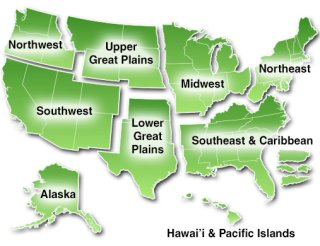Implications of Climate Change
There are many resources available that describe the implications of climate change. Some present information on historically observed changes (e.g., temperature, precipitation) while others project changes into the future based on alternative scenarios (e.g. frequency of intense storms in the future).
ARC-X has a particular focus on climate impacts related to EPA's statutory responsibilities, as the Agency works to fulfill its mission of protecting human health and the environment.
For those interested in learning more about the implications of climate change, links to resources are provided below.
- Climate Impacts and the EPA – Explore links to view brief descriptions of climate change impacts organized around EPA's programmatic roles and responsibilities.
- Regional Climate Impacts – Explore links to view climate impacts at the regional level, including examples of community adaptation.
State Climate Impacts – Explore links to view climate impacts at the state level.
Climate Impacts and the EPA
EPA's work on climate change adaptation is limited in scope by our statutes. Visit the links below to see how climate change can affect its programmatic responsibilities.
Air Quality
- Indoor Air Quality and Climate Change Adaptation – Climate change can increase the growth of indoor fungi and mold.
- Outdoor Air Quality and Climate Change Adaptation – Climate change can increase ground-level ozone and particulate matter.
Water Management
- Water Utility Operations and Climate Change Adaptation – Climate change can complicate water utility operations through more frequent and intense drought events and storms, more rapid sea-level rise, salt water intrusion, and impacts on source water quality.
- Water Quality and Climate Change Adaptation – Climate changes, including more frequent and intense droughts and storms, threaten to affect water quality in rivers, lakes, and streams.
- Ecosystem Protection and Climate Change Adaptation – Climate change can threaten ecosystem protection efforts.
Waste Management & Emergency Response
- Contaminated Site Management and Climate Change Adaptation – The management of hazardous and non-hazardous wastes will become more difficult due to flooding and drought.
- Disaster Debris Management and Climate Change Adaptation – To ensure state, tribal, local and regional resources are not overwhelmed, clean-up efforts require advanced planning and coordination among individuals at levels of government and the private sector with expertise in waste management.
Public Health
- Public Health and Climate Change Adaptation – Climate change affects public health.
- Air Quality and Health – Climate Change Adaptation – Climate change impairs EPA's efforts to attain and maintain safe outdoor and indoor air quality.
- Water Quality and Health – Climate Change Adaptation – An increase in average temperature and the increase in the frequency and intensity of storms, can affect drinking and recreational water quality.
- Chemical Exposure and Health – Climate Change Adaptation – More frequent and intense storms can increase the likelihood of flooding, causing chemicals held in underground storage tanks, landfills, and storm debris to leak or spread to previously unsoiled areas. Melting of permafrost in Alaska can also cause chemical releases.
- Extreme Heat and Health – Climate Adaptation – Climate change is expected to increase the frequency, duration, and intensity of heat waves, affecting public health.
Regional Climate Impacts
Explore the links below to learn more about the regional implications of climate change.
- Regional Impacts – See the most recent summary of climate impacts by the Fifth National Climate Assessment (NCA5) in the NOAA NCA5 Archive Repository.
- Adapting to Climate Change – See examples of how communities are adapting to climate change by NCA region.
| Regional Hazards & Impacts | Adaptation Examples |
|---|---|
| Northeast – see Chapter 21 in the NOAA NCA5 Archive Repository | Northeast |
Southeast – see Chapter 22 Caribbean – see Chapter 23 | Southeast & Caribbean |
| Midwest – see Chapter 24 | Midwest |
Northern Great Plains – see Chapter 25 Southern Great Plains – see Chapter 26 | Great Plains |
| Southwest – see NCA5 Chapter 28 | Southwest |
| Northwest – see NCA5 Chapter 27 | Northwest |
| Hawai'i & Pacific Islands – see Chapter 30 | Hawai'i & Pacific Islands |
| Alaska – see Chapter 29 | Alaska |
State Climate Impacts
New climate summaries from NOAA offer up-to-date, local perspectives on climate in each state, covering the entire United States plus Puerto Rico and the U.S. Virgin Islands.

